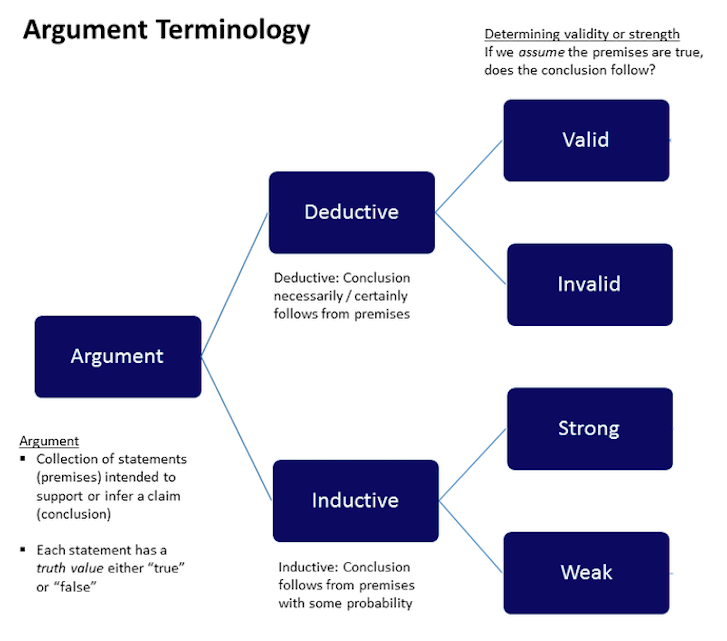Learning Objectives
- Differentiate between deductive and inductive reasoning
Deductive and Inductive Arguments: Two Ways of Understanding
We have two basic ways of reasoning to determine whether something is true: deductive reasoning and inductive reasoning.
Deductive Reasoning: From General to Specific
Deductive reasoning starts with a general principle (premises) assumed to be true and determines what must logically follow. If the premises are correct, the conclusion is guaranteed to be true (in other words, you can provide absolute proof of your conclusions). However, the premises themselves are often unproven, or sometimes unprovable.
Examples: Deductive reasoning
- If it is raining, the ground will be wet. It is raining outside. Therefore, the ground is wet.
- To legally drive, a person must have a valid driver’s license. Emma is driving a car. Therefore, Emma must have a valid driver’s license.
- To earn a bachelor’s degree, a student must have 120 credits. Sally has 130 credits. Therefore, Sally has a bachelor’s degree.
Each of these follows the general rule → specific case → logical conclusion structure of deductive reasoning.
Inductive Reasoning: From Specific to General
Inductive reasoning moves in the opposite direction—it begins with specific observations and uses them to form a general conclusion. By identifying patterns, we infer a broader principle that explains the data.
However, unlike deduction, induction does not prove a theory—it only suggests a likely (or probable) explanation. Alternative explanations may exist, and additional evidence is needed to confirm the conclusion.
The key to inductive reasoning is ensuring that the conclusion logically explains the data. A conclusion that ignores relevant evidence or contradicts observations would not be logically sound.
Examples: Inductive reasoning
-
Every dog I’ve met at the park has been friendly. Therefore, all dogs at the park are friendly.
-
Every time I eat dairy, I feel sick. So, I may be lactose intolerant.
-
Every summer in the past five years, there have been record-high temperatures in my city. Thus, summers are getting hotter in my city.
-
In every election I’ve followed, voter turnout increases when there is a hotly debated issue on the ballot. Therefore, controversial issues lead to higher voter turnout.
Each of these examples follows the specific observations → general conclusion structure of inductive reasoning. Unlike deductive reasoning, these conclusions are probable but not guaranteed—further evidence could support or challenge them.
Key Takeaway: Deductive vs inductive Reasoning
- Inductive arguments move from specific observations to a general conclusion (seeing a pattern and making a rule). They aim to establish a high probability of the conclusion being true, but they cannot guarantee it.
- Deductive reasoning starts with a general rule and applies it to specific cases (knowing a rule and expecting examples to follow it). They guarantee the truth of the conclusion if the premises are valid.

Example: Deductive vs Inductive reasoning
Here is an example of how you might reach a conclusion differently if you are applying deductive or inductive reasoning.
Deductive Reasoning
You read in the news that this grocery store has a tradition of employees wearing football jerseys on Fridays.
- Today is Friday.
- You go to the grocery store.
- The clerks are wearing football jerseys.
Because you started with a general rule and applied it to a specific case, you deduce that the clerks wear football jerseys on Fridays to support the local team.
Inductive Reasoning
You visit your local grocery store every day.
- Two weeks ago, on Friday, the clerks wore football jerseys.
- Last Friday, they wore them again.
- Today, another Friday, they are also wearing jerseys.
Based on these observations, you induce that the clerks wear football jerseys every Friday to support the local team.
Deduction and induction by themselves are inadequate to make a compelling argument. While deduction gives absolute proof, it never makes contact with the real world, there is no place for observation or experimentation, and no way to test the validity of the premises. And, while induction is driven by observation, it never approaches actual proof of a theory. Therefore an effective paper will include both types of logic.

Figure 2. This diagram summarizes some of the key terminology related to arguments: they can be either deductive, in which the conclusion follows the general premises, or inductive, in which a probable conclusion is reached based on some observed premises. You can determine the validity or the strength of an argument by assuming that the premises are true, then seeing if the conclusion is the expected result.
Watch It
This video reviews some of the distinctions between inductive and deductive reasoning.
You can view the transcript for “Inductive VS Deductive Reasoning by Shmoop” here (opens in new window).
Try It
Glossary
deductive reasoning: top-down reasoning; a method of reasoning in which a certain conclusion follows general premises.
inductive reasoning: bottom-up reasoning; a method of reasoning in which several premises provide evidence of a probable conclusion.
Candela Citations
- Image of inductive and deductive reasoning. Provided by: Lumen Learning. License: CC BY: Attribution
- Argument Terminology. Authored by: Farcaster. Located at: https://en.wikipedia.org/wiki/Argument#/media/File:Argument_terminology_used_in_logic.png. License: CC BY-SA: Attribution-ShareAlike
- Inductive VS Deductive Reasoning by Shmoop. Authored by: Shmoop. Located at: https://www.youtube.com/watch?v=VXW5mLE5Y2g&feature=youtu.be. License: Other. License Terms: Standard YouTube License
- Inductive and Deductive Reasoning. Provided by: Utah State University. Located at: http://ocw.usu.edu/English/introduction-to-writing-academic-prose/inductive-and-deductive-reasoning.html. Project: English 1010 Handbook. License: Public Domain: No Known Copyright
- The Logical Structure of Arguments. Authored by: Radford University. Located at: http://lcubbison.pressbooks.com/chapter/core-201-analyzing-arguments/. Project: Core Curriculum Handbook. License: Public Domain: No Known Copyright
